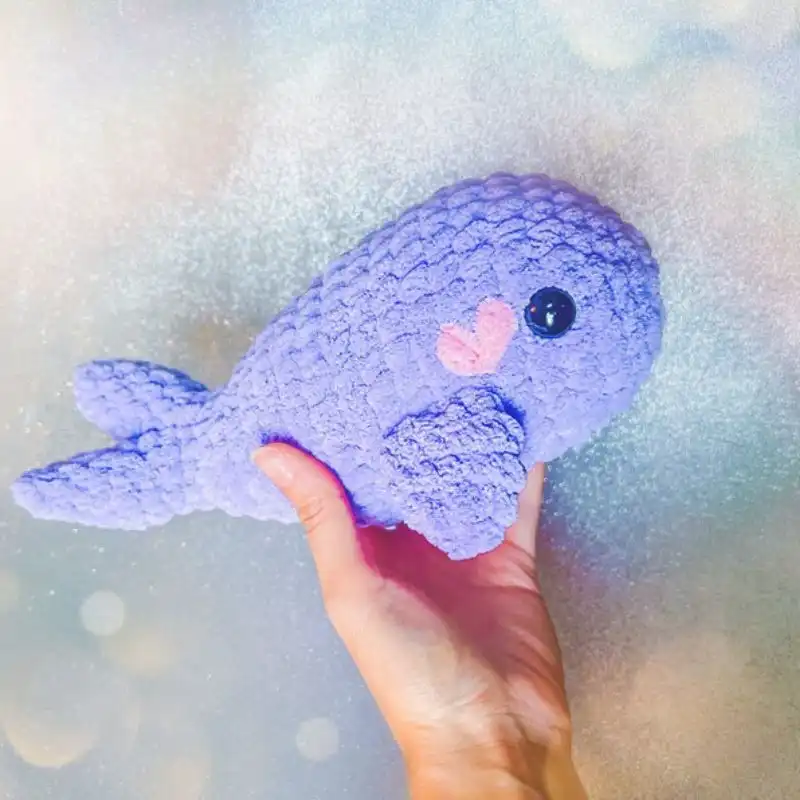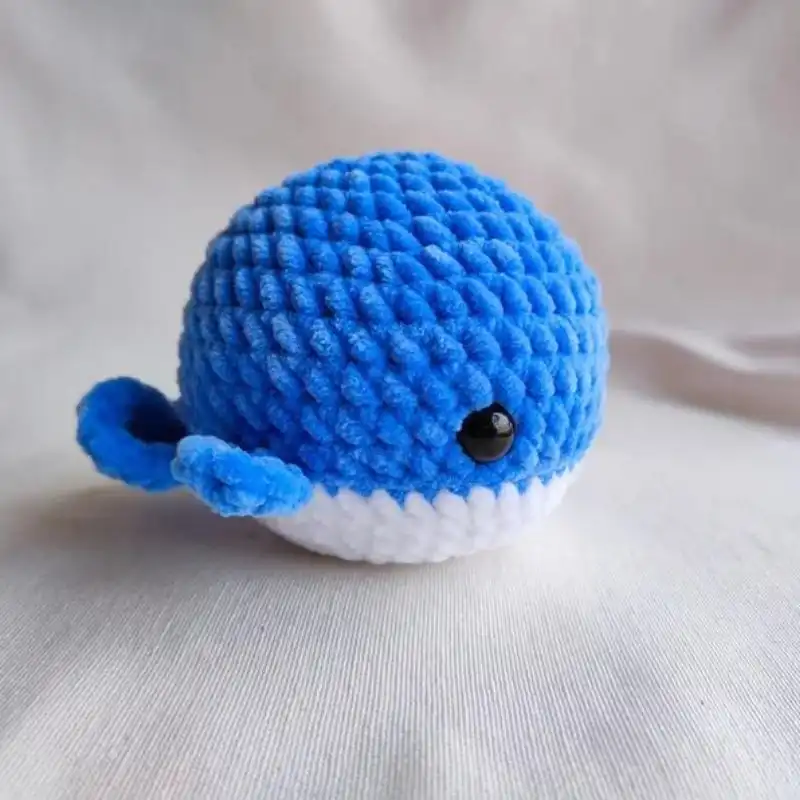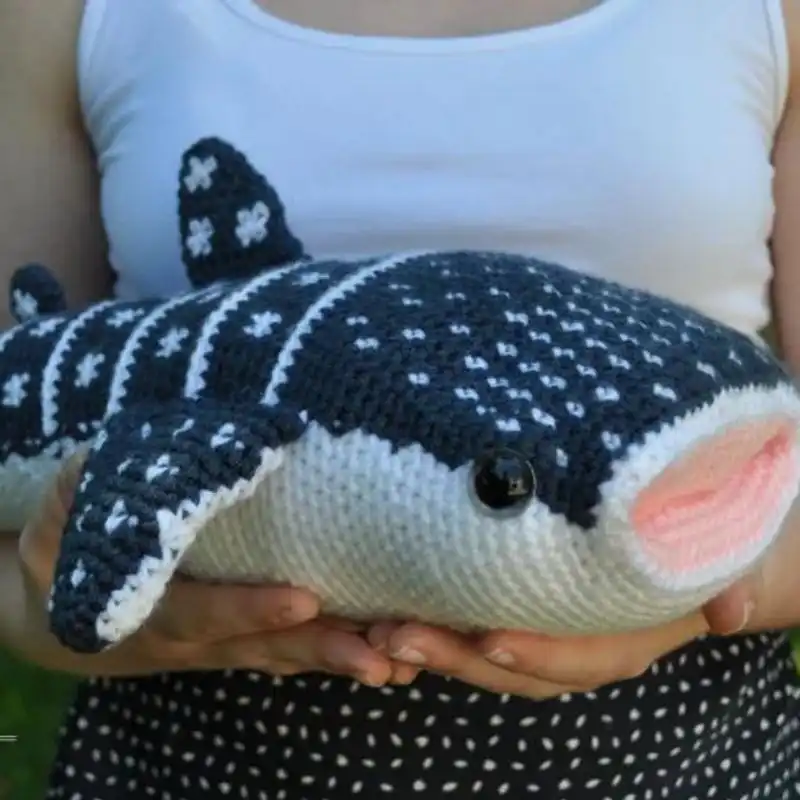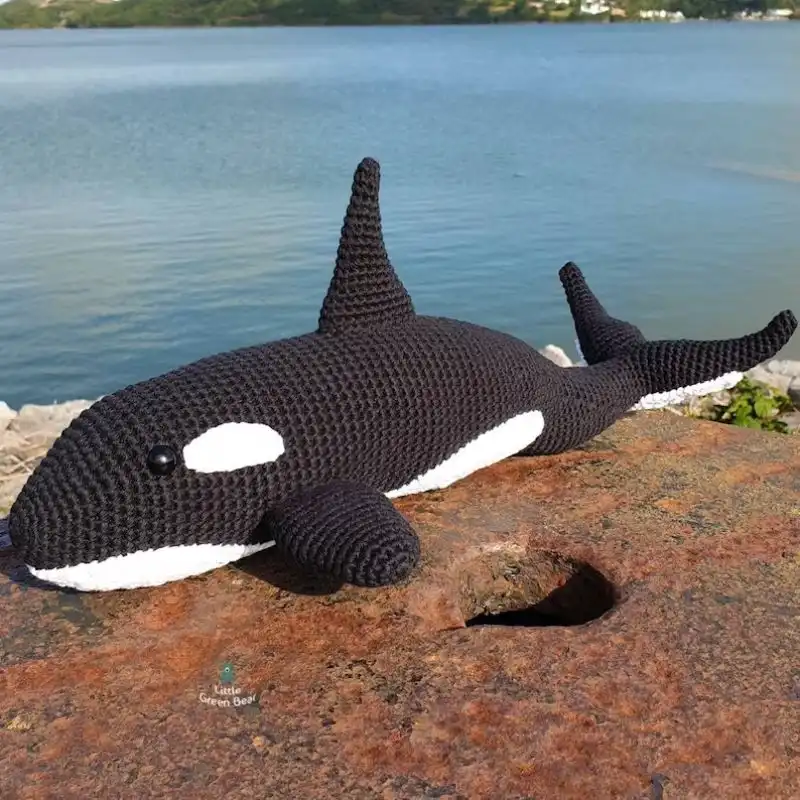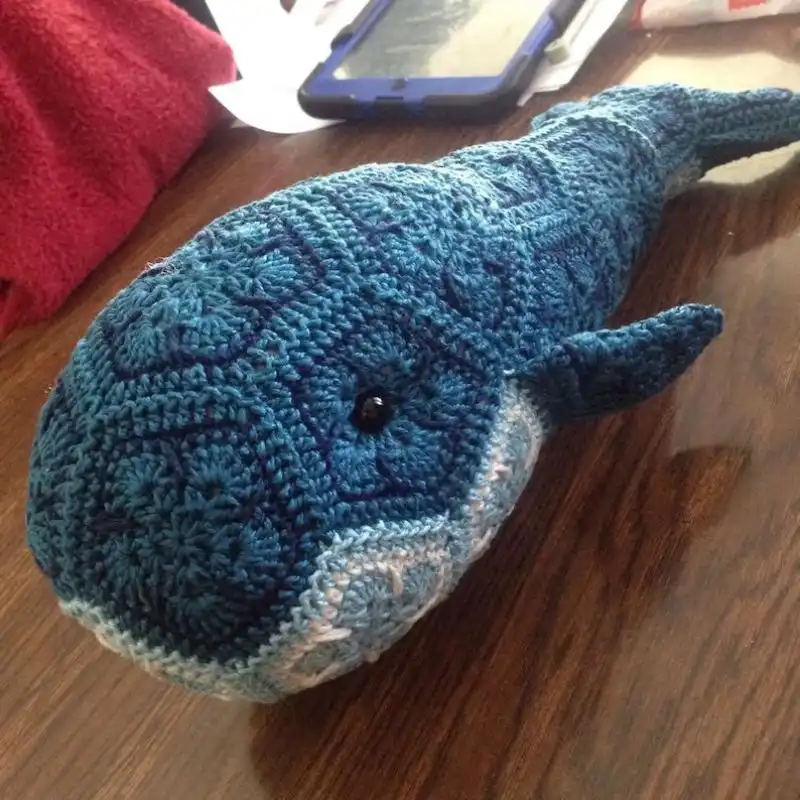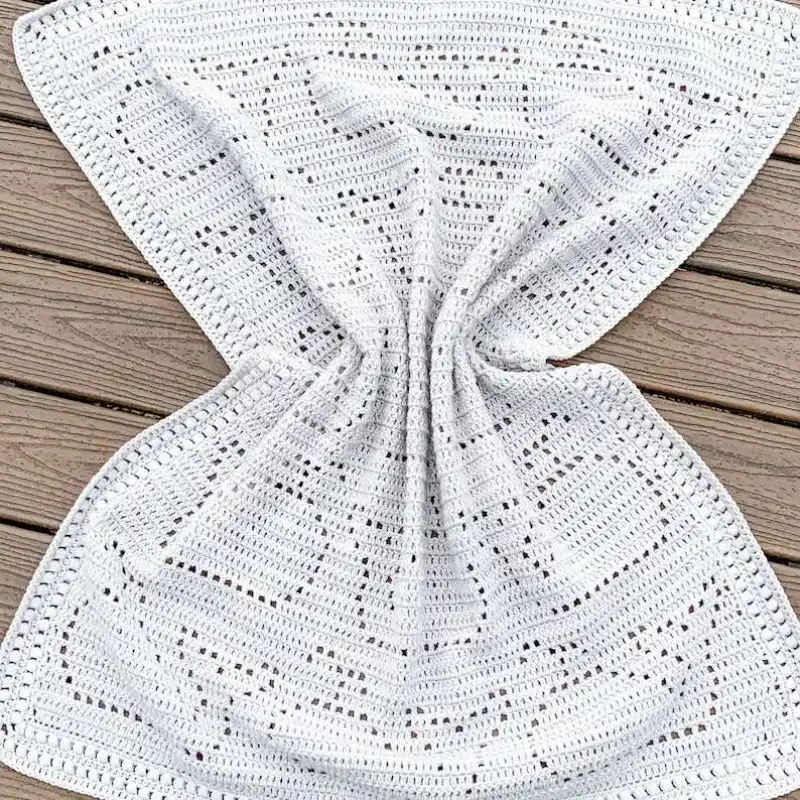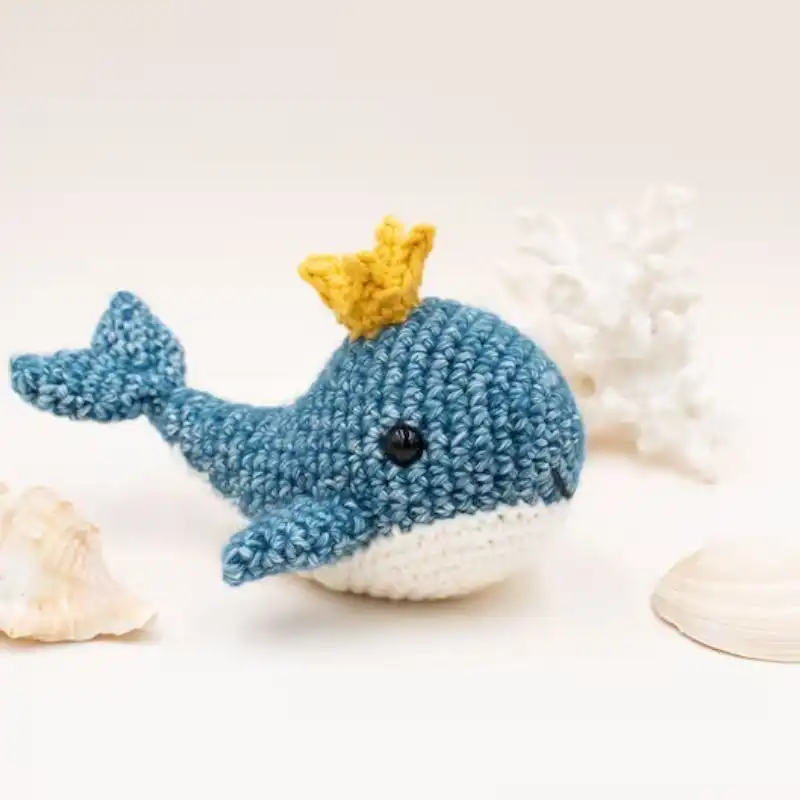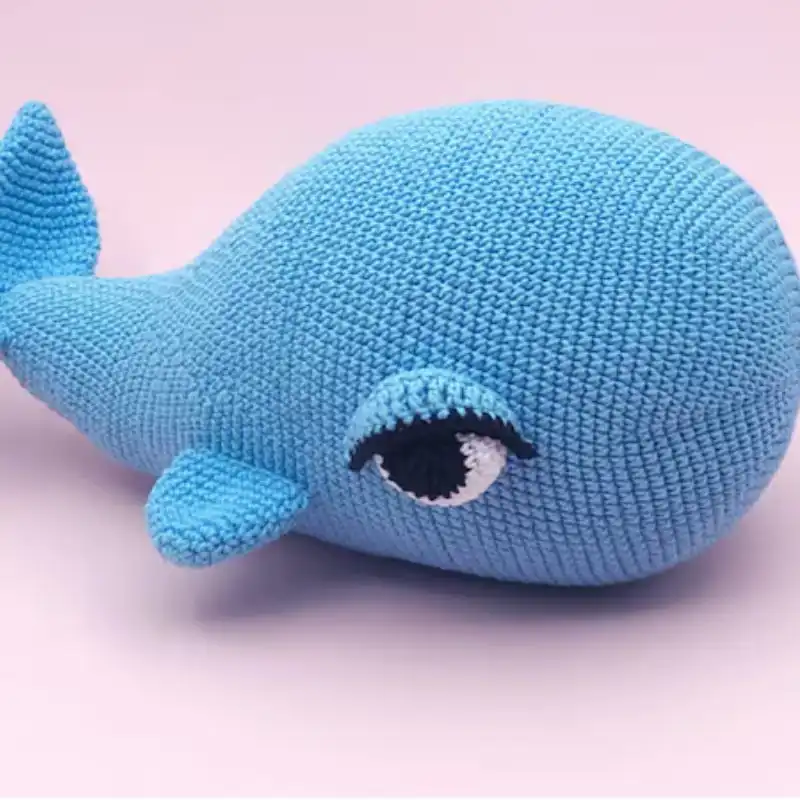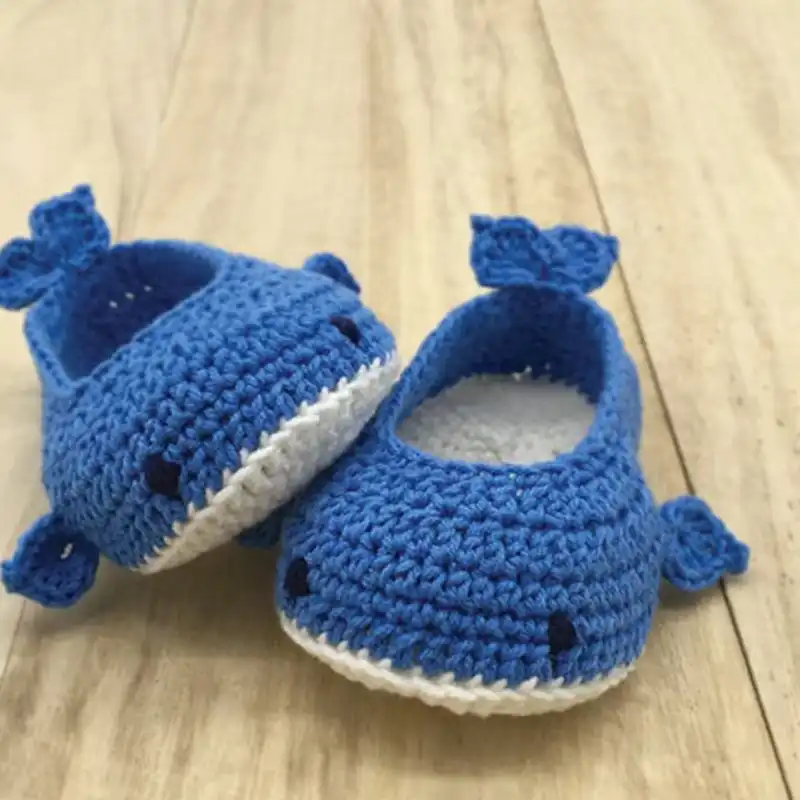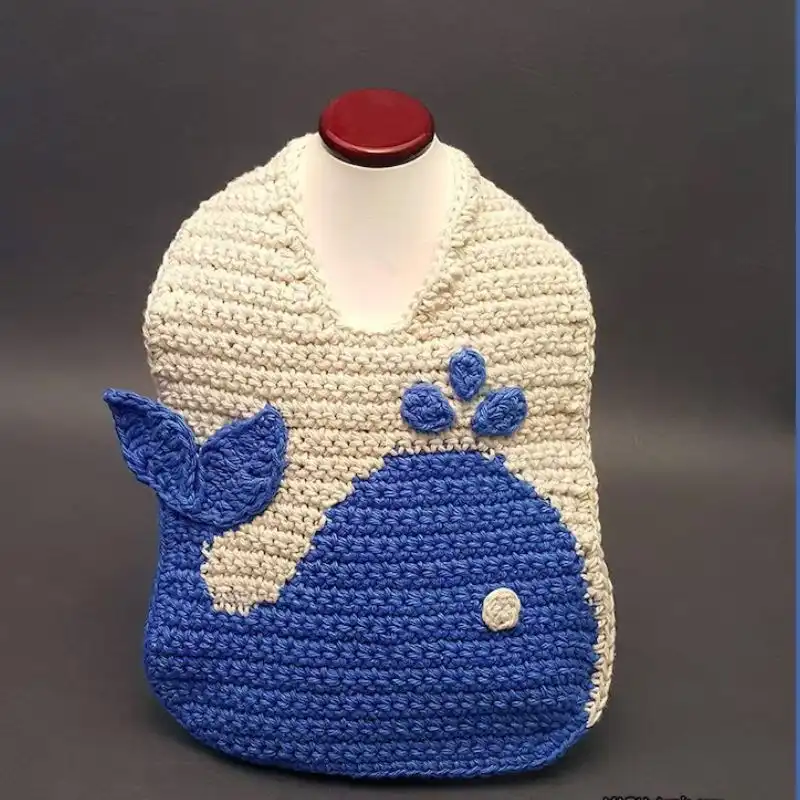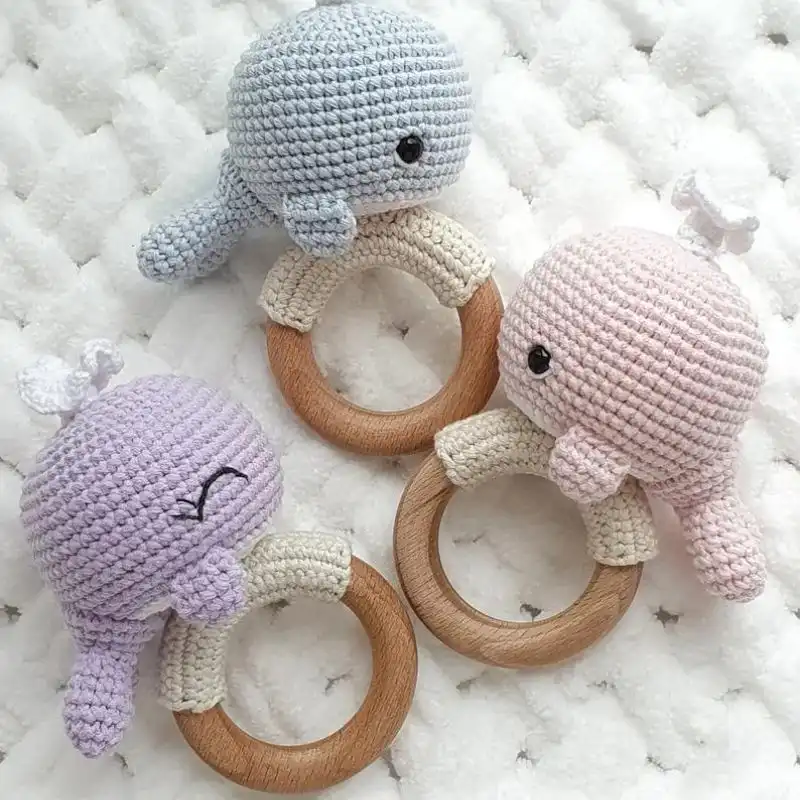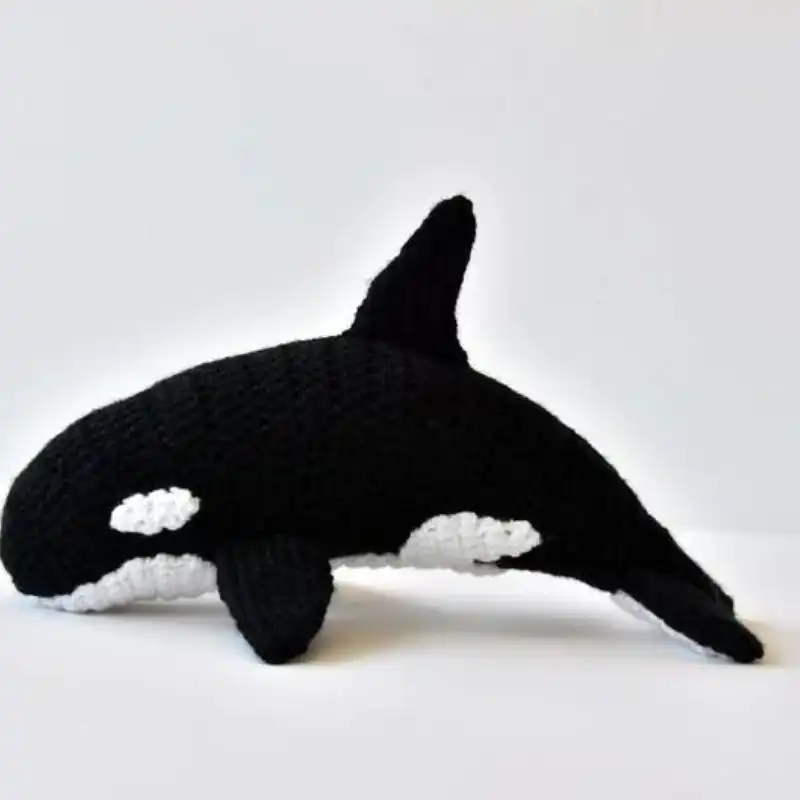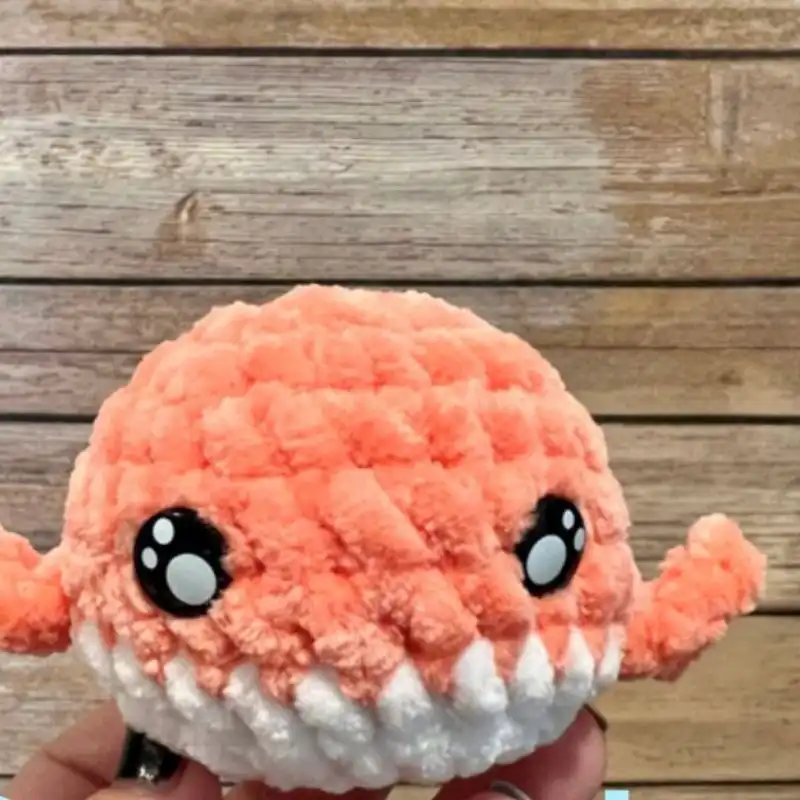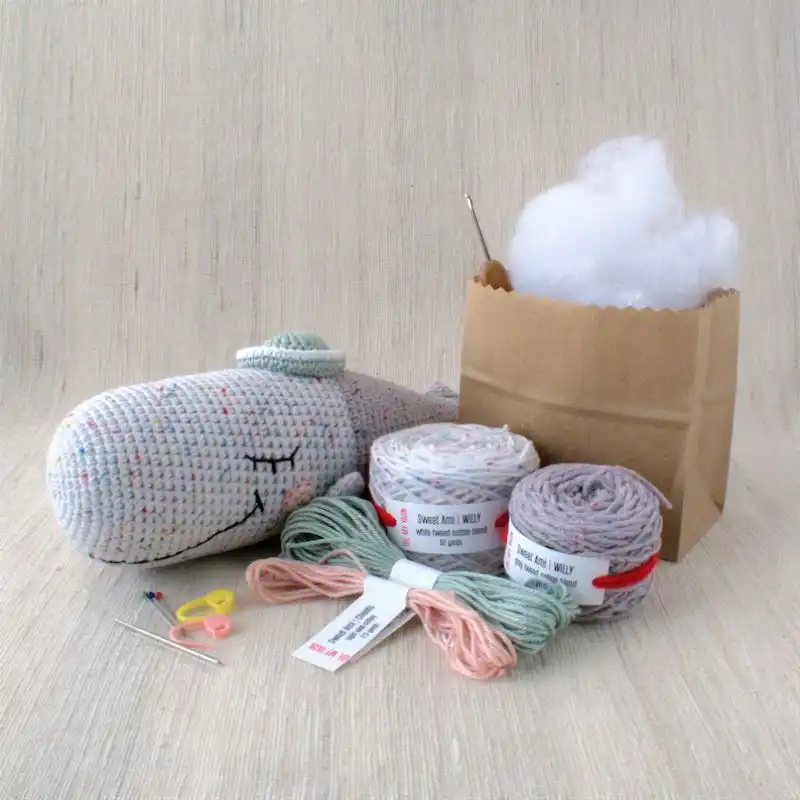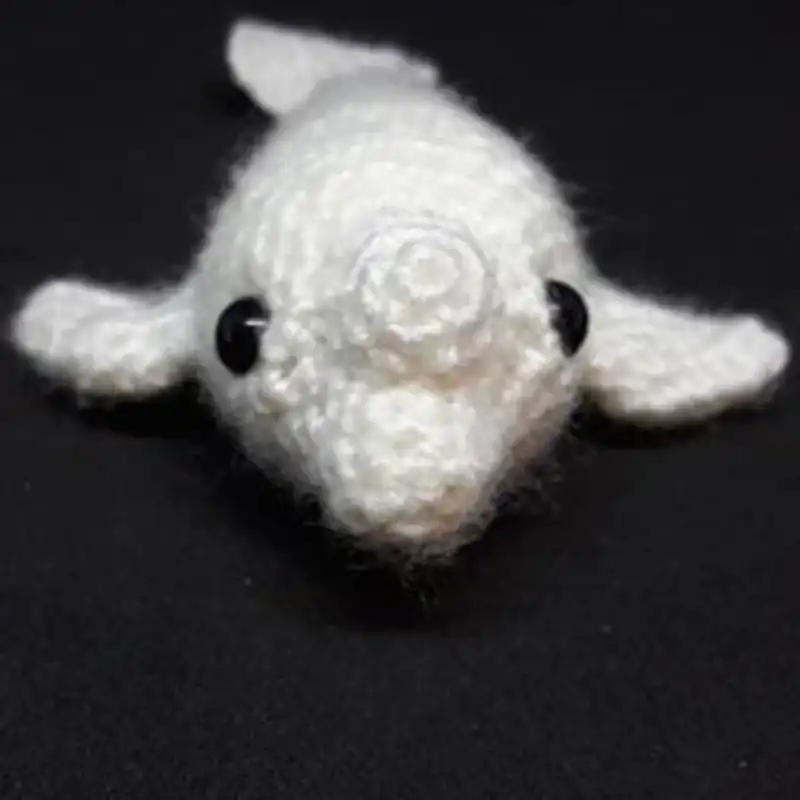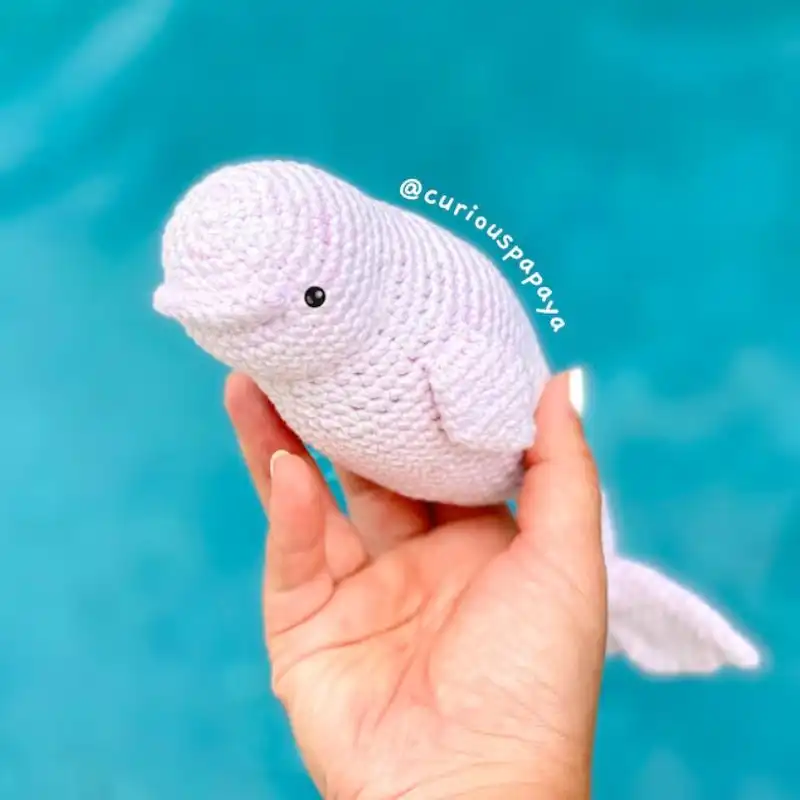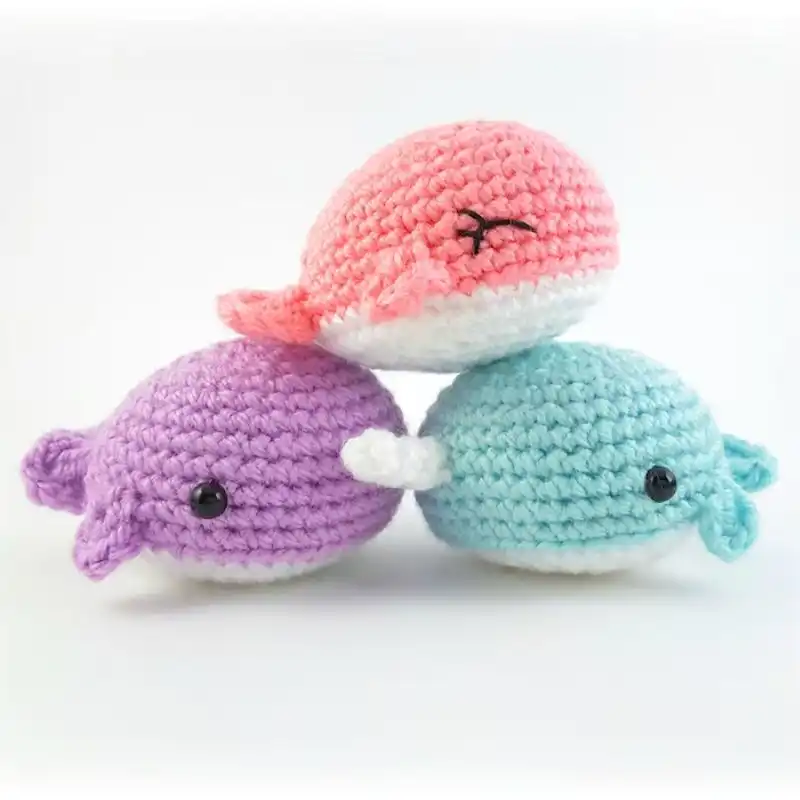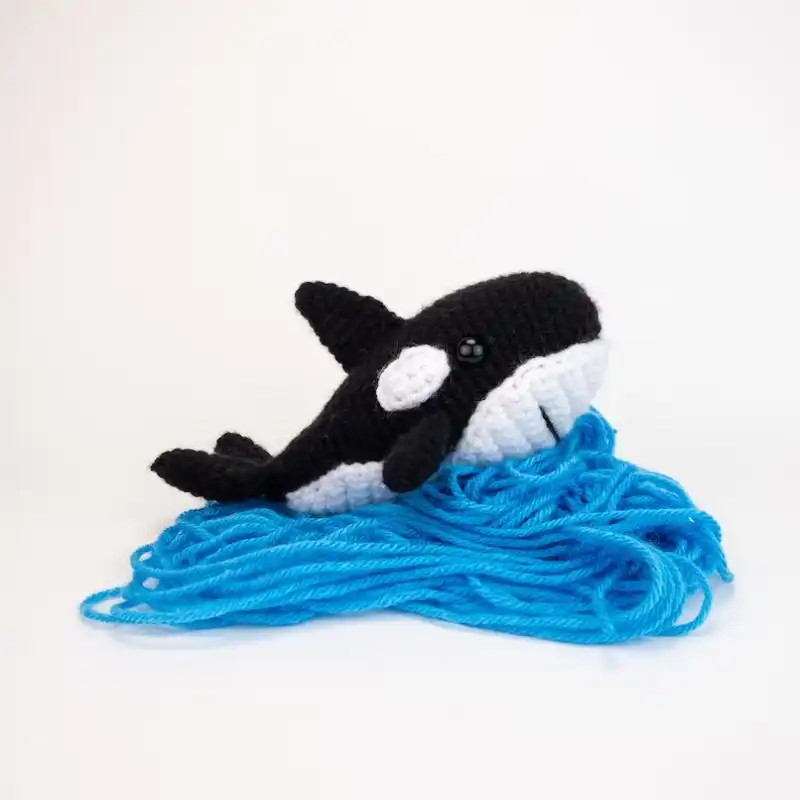Whales are often considered the gentle giants of the sea and so it is no surprise that people love them. Whales are incredibly popular when it comes to items such as plushies and soft toys but they are also popular with knitters and crocheters too.

If you are a fan of crochet, then why not consider making an adorable whale companion for yourself or as a gift for a loved one?
There are a lot of crochet patterns available if you are considering making a cute and cuddly whale, so let’s take a look at 24 of these patterns and where to find them!
What Is A Crochet Whale?
A Crochet Whale is a handmade, artistic creation, often made as a charming toy or decorative piece. It’s crafted using the age-old technique of crochet, which involves looping and intertwining yarn with a hooked needle to create a textured fabric.
The final design depicts a whale with features like a spout, flippers, and a tail. Colors and styles can vary significantly, from realistic hues of blue and grey to vibrant, whimsical shades.
Crochet whales can be a perfect DIY project for craft enthusiasts, a heartwarming gift for loved ones, or a creative learning tool for children exploring marine life.
Is It Worth To Crochet A Baby Whale?
The value of crocheting a baby whale—or any craft project—can vary from person to person based on several factors. Here are some points to consider to determine if it’s worth it for you:
Personal Satisfaction and Skill Building
- Creativity: Crocheting allows you to express your creativity. Designing or following a pattern for a baby whale could be an enjoyable and satisfying process.
- Skill Level: If you’re looking for a project to help you build your crocheting skills, a baby whale could be just the thing. You’ll likely learn new stitches or techniques to apply to future projects.
- Stress Relief: Many people find crocheting to be a relaxing activity that helps them reduce stress.
Functionality
- Toy: If the baby whale is being made as a toy, it could provide a child with much joy and comfort.
- Decor: A crocheted baby whale could make a cute decoration for a room, especially one with a nautical or oceanic theme.
Gift-Giving
- Personal Touch: Handmade gifts often carry more sentimental value than store-bought ones.
- Cost: Materials for a crocheting project can sometimes be cheaper than buying a finished product, although this can vary. Plus, your time and skill add value.
Environmental Consideration
- Sustainable: Handmade items, mainly if made from sustainable materials, can be more eco-friendly than mass-produced items.
Time Commitment
- Consider how much time you have available to devote to the project and whether you feel the end result will be worth that time investment.
Monetary Benefits
- Selling: If you are considering making items to sell, smaller projects like a baby whale could be quicker to produce and offer a lower price point for buyers.
Sentimental Value
- Heirloom: Handmade items like this can become family keepsakes.
Popularity & Versatility Of Crochet Whales
Crochet whales have surged in popularity due to their charming aesthetic, versatility, and the personal connection crafters have with creating something by hand.
They’re often used as toys, home decorations, or unique handmade gifts with sentimental value. Their appeal extends beyond the crafting community, with many purchasing artisan creations from craft markets or online platforms such as Etsy.
The versatility of crochet whales lies in the flexibility of crochet as an art form. Patterns can be adapted to change the size, color, and even whale species, allowing for customization that caters to individual preferences.
Some may feature a simple design for beginners, while others might incorporate intricate patterns, showcasing the complexity and beauty of advanced crochet work.
Moreover, crochet whales have been integrated into various forms of merchandise, including keychains, bag charms, and mobile hangings. This adaptability of crochet whales further contributes to their popularity and wide-ranging appeal.
RELATED: 27 Beautiful Crochet Headband And Ear Warmer Patterns (With Pictures)
Popular Stitches To Crochet Whales
Crocheting a whale involves using various stitches to create different shapes and textures. While the specific stitches you might use can vary depending on the pattern, here are some popular stitches commonly used in amigurumi or other small crochet projects like a baby whale:
Basic Stitches
- Single Crochet (sc): This is the most commonly used stitch in amigurumi, providing a tight fabric that is ideal for stuffed animals.
- Slip Stitch (sl st): Often used to join rounds or to move your yarn to a different starting point without adding height.
- Chain (ch): Used to begin most crochet projects and to create loops, often used for making the tail or fins.
Increases and Decreases
- Single Crochet Increase (sc inc): Two single crochets in the same stitch to increase the number of stitches.
- Single Crochet Decrease (sc dec): Crocheting two stitches together to reduce the number of stitches. This is especially useful for shaping the whale’s body.
Textural Stitches
- Half Double Crochet (hdc): This stitch might be used to add a slightly different texture or height to some parts of the whale, like fins or flippers.
- Double Crochet (dc): Generally taller than the single crochet and half-double crochet, this stitch is less commonly used in amigurumi but could be used for unique texture or decorative features.
- Bobble Stitch: Sometimes used for added texture, perhaps for making barnacles or other features on the whale’s skin.
- Loop Stitch: This can be used to create a “furry” or “spiky” texture, perhaps for a different species of whale, or to give the whale a more unique appearance.
Special Techniques
- Magic Ring: Many amigurumi projects start with a magic ring to create a tight circle with no hole in the middle, which would be ideal for the whale’s snout or tail.
- Invisible Decrease: A form of single crochet decrease that is less visible and thus better for projects where appearance is essential.
- Color Changes: Techniques for changing colors neatly may be necessary if your whale has multiple colors.
Essential Tools & Materials
- Crochet Hooks: The size will depend on the thickness of your yarn and the pattern you’re following.
- Yarn: The color and thickness can be chosen according to your preference and the pattern instructions.
- Stitch Markers: These are used to mark important spots in your pattern.
- Yarn Needle: This is used for weaving in ends and sewing parts together.
- Scissors: A pair of sharp scissors is required for cutting yarn.
- Polyfill Stuffing: This is used to fill your crochet whale and give it shape.
- Safety Eyes: These are used to create the eyes of the whale, but they can be substituted with embroidery if the toy is for a very young child.
- Pattern: A pattern will provide step-by-step instructions on how to create your crochet whale.
Glossary Of Common Crochet Stitches And Techniques
- Chain (ch): A chain stitch is a simple loop of yarn, the foundation of most crochet projects.
- Single Crochet (sc): The most basic crochet stitch is created by inserting the hook into the stitch, yarning over, and pulling through. Yarning over again, and pulling through the loops on the both sides of the hook works well.
- Half Double Crochet (hdc): This stitch is halfway between a single crochet and a double crochet in height. Yarn over, insert the hook into the stitch, yarn over again, and pull through, then yarn over and pull through all three loops on your hook.
- Double Crochet (dc): A taller stitch that’s made by yarning over, inserting the hook into the stitch, yarning over and pulling through, yarning over and pulling through two loops, then yarning over again and pulling through the remaining two loops.
- Treble Crochet (tr): This is an even taller stitch, made by yarning over twice before inserting your hook into the stitch.
- Slip stitch (sl st): A method to move yarn across stitches without adding height or joining work when working in rounds.
- Increase (inc): Make two stitches in one stitch from the previous row to widen your work.
- Decrease (dec): Combining two stitches from the previous row into one stitch to narrow your work.
- Magic Ring or Circle: This technique is often used to start a project that is worked in rounds, such as amigurumi.
- Yarn Over (yo): Wrapping the yarn over your crochet hook. This is used in many different stitches.
- Fasten Off (FO): To finish the work and secure the yarn so it won’t unravel.
- Working in Rounds: You work in a spiral without joining each row’s beginning and end with a slip stitch.
- Working in Rows: You turn your work at the end of each row and start a new one.
- Joining with a Slip Stitch (join with sl st): Often used at the end of a round to bring the first and last stitches together.
- Stitch Marker: A tool used to mark a specific stitch in your work, often the first stitch of a round in amigurumi.
Understand Crochet Stitches & Patterns
Understanding crochet stitches and patterns can be challenging, especially for beginners. Here are some tips that might help:
- Know the Basics: Familiarize yourself with basic stitches and abbreviations used in crochet. Many patterns assume knowledge of these fundamentals. Having a handy glossary or guide to refer to can be helpful.
- Understand the Symbols: Crochet patterns often include symbol diagrams. Each symbol represents a specific stitch, and the diagram as a whole visually represents what your crochet work should look like at each stage.
- Recognize International Differences: Crochet terms can differ between U.S. and U.K. patterns. For instance, a U.S. single crochet (sc) is a double crochet (dc) in the U.K. Make sure you know your pattern’s terminology.
- Start with Simple Patterns: If you’re a beginner, start with simple patterns that primarily use basic stitches. As your skills improve, you can progress to more complex patterns.
- Read Through the Pattern: Before starting, read through the entire pattern to understand what is required. Look for any unfamiliar stitches or techniques and learn these beforehand.
- Use Stitch Markers: Stitch markers are handy when working in the round (common in amigurumi) or for marking pattern repeats in complex designs.
- Practice Gauge: This is especially important for wearable items where size matters. If your gauge differs from the pattern’s, your finished product may need a different size. Adjust hook size or tension to match the pattern’s gauge.
- Patience and Practice: Remember that understanding crochet stitches and patterns takes time and practice. Take your time with initial difficulties. Keep practicing, and you’ll become more confident and skilled with time.
Which Yarn Is Best For Crochet Whales?
Choosing the suitable yarn for your crochet whale largely depends on your intended use for the finished product. Here are some options:
- Worsted Weight Yarn: This medium-thickness yarn is ideal for beginners. It’s easy to work with, and the stitches are visible, which helps you learn and spot any mistakes. It’s an excellent choice for a toy that needs to be robust and durable.
- Cotton Yarn: This yarn is durable, maintains its shape well, and can be machine washed, which makes it an excellent choice for crochet toys like whales that might need frequent cleaning. It’s also suitable for achieving a more defined stitch definition.
- Acrylic Yarn: This is a versatile, cost-effective, and widely available yarn. It’s easy to care for, as it’s usually machine washable and dryable. However, it may not be as breathable as natural fibers.
- Baby Yarn: If the crochet whale is intended for a baby or toddler, yarns labeled as ‘baby’ could be a good choice. These yarns are typically soft, hypoallergenic, and machine washable. They are often lighter (like sport or DK), but you can also find them in worsted weight.
- Chunky/Bulky Yarn: Chunky or bulky yarn could be the best choice if you want to make a larger crochet whale. You’ll complete the project faster with this thicker yarn, resulting in a large, cuddly toy.
How Much Yarn Do I Need To Crochet Whale?
The amount of yarn required to crochet a whale varies greatly depending on several factors, such as:
- Size of the Whale: A small keychain-sized whale will require significantly less yarn than a large, plush-sized whale.
- Type of Yarn: Thicker yarns, like bulky or chunky types, cover more surface area and thus require less yardage than thinner yarns like sport or fingering weight.
- Crochet Stitch: Some stitches use more yarn than others. For instance, single crochet stitches use less yarn than double crochet stitches for the same-sized item.
- Pattern: Different patterns might require different amounts of yarn due to variations in design, stitch types, and size.
A small amigurumi whale (around 5-7 inches long) might require around 100-150 yards of medium-weight yarn (like worsted weight). You’ll need more for larger whales or those made with thinner yarn.
Most patterns specify the amount of yarn required, so it’s best to check your chosen pattern for the most accurate estimation.
Is It Beginner-Friendly?
Crocheting a whale can certainly be beginner-friendly, depending on the complexity of the pattern. For someone new to crocheting, starting with a basic pattern that uses simple stitches and techniques is best.
An easy-to-follow pattern would primarily include basic stitches like the chain stitch, single crochet, and slip stitch. Techniques like working in the round or increasing/decreasing might also be involved, but these are relatively straightforward to learn with some practice.
Amigurumi, a technique often used to crochet animals or figures like a whale, is popular among beginners due to its modular nature. Many parts of an amigurumi project (like a whale’s body, tail, and fins) are worked up separately and then sewn together, making the project more manageable for beginners.
However, like any new skill, crochet requires practice and patience. It’s normal to make mistakes or have to redo parts of your project, so keep going if your first attempt isn’t perfect. Over time, your skills and confidence will grow, and you’ll be able to tackle more complex projects.
How To Crochet A Basic Beginner-Friendly Whale?
Crocheting a basic beginner-friendly whale can be a fun and rewarding project. Here’s a simple step-by-step guide to help you make your own crochet whale. Note that I’ll be using U.S. crochet terms for this pattern.
Materials Needed
- Worsted weight yarn in two colors: one for the whale body (e.g., blue or gray) and one for the water spout (e.g., white)
- Size G (4.00 mm) crochet hook
- Fiberfill stuffing
- Yarn needle
- Safety eyes or black yarn for eyes
- Stitch markers
Abbreviations
- sc: single crochet
- inc: increase (two single crochet in the same stitch)
- dec: decrease (crochet two stitches together)
- sl st: slip stitch
- ch: chain
- st: stitch
- Rnd: Round
Instructions
Body
Rnd 1: Start with a magic circle and crochet 6 sc into it. Pull the circle tight.
Rnd 2: Inc in each st around (12 sc).
Rnd 3: [1 sc, inc] x 6 (18 sc).
Rnd 4: [2 sc, inc] x 6 (24 sc).
Rnd 5: [3 sc, inc] x 6 (30 sc).
Rnd 6-10: Sc in each st around (30 sc).
Rnd 11: [3 sc, dec] x 6 (24 sc).
Rnd 12: [2 sc, dec] x 6 (18 sc).
Attach safety eyes between Rnds 8 and 9, with about 4-5 stitches between them.
Start stuffing the body with fiberfill.
Rnd 13: [1 sc, dec] x 6 (12 sc).
Rnd 14: Dec x 6 (6 sc).
Fasten off and weave in ends. Add more stuffing if necessary before closing the hole.
Tail
Ch 6.
- Starting from the second ch from hook, sc in next 4 ch, 3 sc in the last ch.
- Now working on the other side of the chain, sc in next 4 ch, sl st to join.
- Fasten off, leaving a long tail for sewing. Attach the tail to the body.
Ch 5.
- Sl st in second ch from hook.
- Sc in next ch.
- Hdc (half-double crochet) in next ch.
- Dc (double crochet) in the last ch.
- Fasten off, leaving a tail to sew onto the body.
Assembly
- Sew the tail to the back end of the whale’s body.
- Sew the water spout onto the top of the whale, between the eyes but a little toward the back.
- If you’re using yarn for the eyes, stitch them on now.
24 Crochet Whale Patterns
There are a lot of crochet patterns available if you are considering making a cute and cuddly whale, so let’s take a look at 24 of these patterns and where to find them!
1. Amigurumi Crochet Whale Pattern
First up, we have this adorable blue whale amigurumi crochet pattern courtesy of LittleLottieCreate on Etsy. This little guy – named Wally the Whale but I’m sure he won’t mind if you change his name upon his creation – is an excellent choice for beginners to crochet. He even has eyebrows!
It may seem like a small addition but it adds a little bit of extra personality to this particular pattern.
Suggested Yarn: Worsted weight acrylic yarn
Difficulty Level: Intermediate
Yarn Weight: Medium (4)
Crochet Hook: 4 mm (G-6)
2. Little Whale Crochet Pattern
If you are still new to crochet and want to try out something a little smaller, then this teeny whale crochet could be perfect for you!
The tiny whale should measure around 8cm tall if you follow the pattern and is made using worsted weight yarn, thin black cotton yarn, stuffing, eye beads, and a 4.5mm crochet hook.
Suggested Yarn: DK weight cotton yarn
Difficulty Level: Beginner
Yarn Weight: Light (3)
Crochet Hook: 3.5 mm (E-4)
3. Crochet Amigurumi Whale
Spin a Yarn Crochet offers a simple yet adorable style of crochet amigurumi whale pattern. The finished product includes a very fancy whale with a top hat and mustache and a lovely lady whale.
This choice of crochet has a unique look in comparison to some of the other options but it is still an easy option even if you are a beginner at tapestry crochet.
Suggested Yarn: Sport weight acrylic yarn
Difficulty Level: Intermediate
Yarn Weight: Light (3)
Crochet Hook: 3.75 mm (F-5)
4. Whitney The Whale Shark Crochet Stuffed Animal Pattern
Alright, so this one is a bit of a cheat as it is technically a shark crochet pattern rather than a whale but we just couldn’t resist including the gorgeous Whitney the Whale Shark!
As is to be expected, this is a more advanced crochet pattern that will take a lot of time and work. It’s advised to take this one only if you are well versed in the art of crochet!
Suggested Yarn: Worsted weight acrylic yarn
Difficulty Level: Intermediate
Yarn Weight: Medium (4)
Crochet Hook: 4.5 mm (7)
5. Large No-Sew Whale Crochet Pattern
As the name suggests, this pattern involves no sewing whatsoever. This adorably chunky whale pattern has been written with super bulky yarn in mind to make him as chubby as possible.
To get started on this design, you’ll need that bulky yarn alongside a 6mm crochet hook, polyester fiberfill, scissors, a stitch marker, and some 21mm safety eyes (or something similar).
Suggested Yarn: Super bulky weight acrylic yarn
Difficulty Level: Beginner
Yarn Weight: Super Bulky (6)
Crochet Hook: 10 mm (N/P-15)
6. Whale Amigurumi Crochet Pattern
Unless you have been living under a rock for the past few years, you have probably at least heard of the South Korean boy band and global sensations that are BTS.
If you are a BTS fan then consider making him with purple yarn – as TheLoftyLoop has – to represent the signature purple color scheme of the band and their fan base. Choose this design to make this whale and ensure that he isn’t lonely anymore!
Suggested Yarn: Worsted weight acrylic yarn
Difficulty Level: Intermediate
Yarn Weight: Medium (4)
Crochet Hook: 4 mm (G-6)
7. Baby Humpback Whale Stuffed Animal Crochet Pattern
This baby humpback whale crochet pattern has so much personality and is surprisingly easy to make- thanks to the use of basic crochet stitches- as long as you have the patience to give it a try!
It is up to you what kind of size you would want to make the humpback. Try out different kinds of yarn to decide on whether you want your whale to be a pint-sized partner or a big, cuddly companion.
Suggested Yarn: Aran weight cotton yarn
Difficulty Level: Intermediate
Yarn Weight: Medium (4)
Crochet Hook: 4.5 mm (7)
8. Olwyn The Orca Crochet Pattern
This is another pattern that is sure to be tricky and will test your crochet skills but the result will be worth it! Olwyn the Orca is recommended for those with an intermediate skill level.
Consider using Aran or worsted weight yarn alongside a 3.5mm crochet hook, plastic safety eyes, a yarn needle, pins, and polyester filling when crocheting this beautiful whale buddy.
Suggested Yarn: Worsted weight acrylic yarn
Difficulty Level: Intermediate
Yarn Weight: Medium (4)
Crochet Hook: 4 mm (G-6)
9. Purdy The African Flower Crochet Whale Pattern
For a crochet pattern that is a little bit different, you may want to consider this beautiful African Flower crochet whale pattern. The heptagon motif is what makes this cute whale stand out.
Purdy can be made with a 2.5mm crochet hook, scissors, a blunt-ended needle, plastic safety eyes, and polyester toy stuffing.
Suggested Yarn: Worsted weight acrylic yarn
Difficulty Level: Intermediate
Yarn Weight: Medium (4)
Crochet Hook: 4 mm (G-6)
10. Crochet Whale Plushie Pattern
The Crochet Whale Plushie Pattern allows you to create an adorable and huggable whale amigurumi.
Once completed, you’ll have a delightful plushie perfect for cuddling or gifting to ocean-loving friends and family. Dive into this pattern and bring this cute underwater creature to life with your crochet skills.
Suggested Yarn: Bulky weight polyester blend yarn
Difficulty Level: Intermediate
Yarn Weight: Bulky (5)
Crochet Hook: 6 mm (J-10)
11. Whale Crochet Blanket Pattern
If a wall hanging is a little too intense to start out with, you could begin with a blanket instead. This would make a great gift but would also be an excellent blanket for yourself too. You will need around 13.5 oz of lightweight DK yarn for this blanket and it is made simple with basic crochet stitches.
Suggested Yarn: Bulky weight acrylic yarn
Difficulty Level: Intermediate
Yarn Weight: Bulky (5)
Crochet Hook: 6 mm (J-10)
12. Baby Whale Amigurumi Crochet Pattern
We may or may not have chosen this baby whale due to the exquisite crown that you are able to make alongside it.
This is a pretty simple pattern that would suit beginners excellently and utilises simple, single crochet techniques. Grab yourself a 2.5mm crochet hook, yarn, fiberfill stuffing, a tapestry needle, stitch marker, some ballpoint pins, and safety eyes to make this little cutie.
Suggested Yarn: Sport weight acrylic yarn
Difficulty Level: Intermediate
Yarn Weight: Light (3)
Crochet Hook: 4 mm (G-6)
13. Bob The Blue Whale Amigurumi Whale Pattern
Bob the Blue Whale is a simple whale with simple pleasures and- in the same vein- he is also pretty simple to make. All you will need for Bob is three skeins of light blue yarn, one skein of white yarn, one skein of black yarn, a needle, some scissors, fiber filling, and a crochet hook of 3.5mm and you are good to go.
When he is finished, he will measure at around 34cm in length and will make an excellent companion for cuddles.
Suggested Yarn: Worsted weight acrylic yarn
Difficulty Level: Intermediate
Yarn Weight: Medium (4)
Crochet Hook: 4.5 mm (7)
14. Whale Crochet Baby Booties Pattern
Not satisfied with hanging whales on the walls, wrapping up in whale blankets, and cuddling with crocheted whale plushies? Well, why not dress your kids up in whale attire too?
These whale baby bootie patterns have no right to be as adorable as they are, complete with tiny eyes, fins, and tails for a dash of extra cuteness.
Suggested Yarn: DK weight cotton yarn
Difficulty Level: Intermediate
Yarn Weight: Light (3)
Crochet Hook: 4 mm (G-6)
15. Blue Whale Baby Bib Crochet Pattern
Whilst we are on the subject of babies, complete your child’s whale-based attire with this lovely crocheted blue whale baby bib! This is another relatively simple project, requiring a 5mm crochet hook, scissors, a yarn needle, and less than 120 yards of yarn (preferably blue if you still want the blue whale in particular!).
Suggested Yarn: Worsted weight cotton yarn
Difficulty Level: Intermediate
Yarn Weight: Medium (4)
Crochet Hook: 4 mm (G-6)
16. Whale Baby Rattle Crochet Pattern
Make the set complete with this baby rattle whale crochet pattern whilst you are at it! Basic crochet skills are needed for this one and you will need cotton, yarn, a 2mm crochet hook, fiberfill stuffing, a sewing needle, scissors, pins, safety eyes, and also rattle related items such as an optional insert and wooden teeth ring.
Suggested Yarn: Aran weight cotton yarn
Difficulty Level: Intermediate
Yarn Weight: Medium (4)
Crochet Hook: 5 mm (H-8)
17. Killer Whale Crochet Pattern
This Killer Whale crochet pattern is another option that is a little bit different, not quite as cutesy as some of the other options on this list. That doesn’t make this crocheted whale any less impressive though, with the final result being a spectacular-looking killer whale crocheted plush.
Suggested Yarn: Worsted weight acrylic yarn
Difficulty Level: Intermediate
Yarn Weight: Medium (4)
Crochet Hook: 4 mm (G-6)
18. Ice Cream Narwhal Whale Amigurumi Crochet Pattern
What happens when an ice cream cone falls on a whale’s head? The whale becomes a narwhal, of course, as demonstrated in this wonderfully creative pattern by BellaKnotteYarnCraft. Despite what you might think, this is basic beginner-level crochet.
Suggested Yarn: Sport weight acrylic yarn
Difficulty Level: Intermediate
Yarn Weight: Light (3)
Crochet Hook: 4 mm (G-6)
19. No Sew Whale Crochet Pattern
Much like Bob, No Sew Whale is also a simple whale who enjoys the simple things in life. No Sew Whale Crochet Pattern is relatively wide and tall when he has been crocheted- and has a simple design that would make for an excellent present.
Suggested Yarn: Bulky weight acrylic yarn
Difficulty Level: Beginner
Yarn Weight: Bulky (5)
Crochet Hook: 6 mm (J-10)
20. Willy The Whale DIY Crochet Amigurumi Kit
Embark on a charming crafting adventure with the Willy The Whale DIY Crochet Amigurumi Kit. This delightful kit includes everything you need to create your own adorable whale amigurumi, from soft yarn and crochet hooks to easy-to-follow instructions. Dive into creativity and bring Willy to life!
Suggested Yarn: Worsted weight acrylic yarn
Difficulty Level: Intermediate
Yarn Weight: Medium (4)
Crochet Hook: 4 mm (G-6)
21. Beluga Whale Crochet Pattern
This crocheted beluga is also super cute, so it’s a win-win scenario. You’ll need a 4mm hook to make this little guy.
This pattern captures the distinctive features of the beluga, including its rounded body, bulbous head, and signature smile. Crocheters can follow along to crochet each element, resulting in a charming and realistic miniature version of this beloved marine mammal.
Suggested Yarn: Sport weight cotton yarn
Difficulty Level: Intermediate
Yarn Weight: Light (3)
Crochet Hook: 4 mm (G-6)
22. Bella The Beluga Crochet Pattern
Whilst we are on the subject of these beautiful, endangered creatures, curiouspapaya also has a cute beluga pattern available via their Etsy. It’s super easy and very much friendly to beginners! Any kind of light worsted yarn will do alongside a 2.75mm crochet hook.
Suggested Yarn: Worsted weight acrylic yarn
Difficulty Level: Intermediate
Yarn Weight: Medium (4)
Crochet Hook: 4.5 mm (7)
23. Whale And Narwhal Amigurumi Patterns
Both the whale and the ever-elusive narwhal can be crocheted within a few hours with this handy pattern and instruction set (though they are suited more for advanced beginners and intermediate crocheters).
These tiny and adorable critters would make excellent gifts and can be made using worsted weight yard wool, 7mm safety eyes, any stuffing (your choice!), scissors, yarn or darning needles, and a 3.5mm crochet hook.
Suggested Yarn: Sport weight acrylic yarn
Difficulty Level: Intermediate
Yarn Weight: Light (3)
Crochet Hook: 4 mm (G-6)
24. Oreo The Orca Crochet Pattern
Oreo’s cuteness cannot be denied and he only requires basic crochet skills to make him with this pattern! A 4mm crochet hook is suggested with some black and white worsted weight yarn, a yarn needle, straight pins, polyester fiberfill stuffing, and 12mm safety eyes.
If you have basic skills in crochet- such as increasing, decreasing, chain and single crochet- Oreo could soon be your little whale companion for life.
Suggested Yarn: Worsted weight acrylic yarn
Difficulty Level: Intermediate
Yarn Weight: Medium (4)
Crochet Hook: 4 mm (G-6)
Do’s & Don’ts For A Safe Crochet Whale
Creating a crocheted whale can be a fun and rewarding experience, but there are some best practices and things to avoid. Here are some do’s and don’ts to help you along the way:
Do’s
- Read the Pattern Thoroughly: Before you start, read through the entire pattern to make sure you understand the techniques, stitches, and materials required.
- Choose the Right Yarn: As previously discussed, the type of yarn you use can significantly affect the final product. Make sure to select a yarn that suits your specific needs and purpose.
- Gauge Swatch: Especially if size is important, make a gauge swatch to ensure that your stitches match those called for in the pattern. This is less crucial for amigurumi like whales, but it’s a good habit nonetheless.
- Use a Stitch Marker: When working in continuous rounds, use a stitch marker to keep track of the beginning of each round.
- Keep Stitches Tight: Tight stitches are essential for amigurumi projects to keep the stuffing from showing through.
- Check Your Tension: Keep an even tension throughout your work to ensure the shape turns out as intended.
- Count Your Stitches: Regularly count your stitches to ensure you are following the pattern accurately. This is especially important in parts that require increases or decreases.
- Take Breaks: Crocheting can be hard on your hands and eyes for long periods. Make sure to take short breaks to stretch and rest.
- Check for Holes Before Stuffing: Before you begin stuffing your whale, ensure there are no visible holes or loose stitches.
- Test Wash a Swatch: If you plan to wash your whale, test wash a swatch of your yarn to make sure it will hold up and not bleed color.
Don’ts
- Don’t Rush: Take your time, especially if you are a beginner. Rushing can lead to mistakes that are hard to fix later.
- Don’t Overstuff: While you want your whale to hold its shape, overstuffing can cause your stitches to stretch and create visible gaps.
- Don’t Ignore Mistakes: If you notice a mistake, it’s generally easier to fix it right away rather than hoping it won’t be noticeable in the finished product.
- Don’t Use Knots for Color Changes: Knots can come undone and are generally not as secure as other methods for changing colors.
- Don’t Forget to Weave in Ends Securely: Loose ends can unravel with use or washing. Make sure to weave in all ends securely to ensure the longevity of your project.
- Don’t Use Unsafe Fillings: If the whale will be used as a toy, especially for young children, avoid using fillings that could be a choking hazard or that are not washable.
- Don’t Ignore Safety Standards: If your crocheted whale is intended for a baby or small child, make sure all elements (like safety eyes or other added features) are securely attached and appropriate for the child’s age.
- Don’t Skimp on Quality: Particularly for heirloom or gift items, using higher quality yarn and fill can make a significant difference in the look and feel of the finished whale.
- Don’t Ignore Fiber Allergies: If you know the whale will be for someone with specific fiber allergies (like wool), choose a hypoallergenic yarn.
Tips & Tricks To Avoid Crochet Mistakes
Crocheting a perfect whale involves attention to detail and patience. Here are some tips and tricks to avoid common crochet mistakes:
- Choose the Right Tools: Make sure your hook size matches your yarn weight. This will help maintain the correct tension and ensure the final product is the right size and shape.
- Follow the Pattern: Ensure you understand all the stitches and techniques before you start. Read through the pattern thoroughly, looking up any unfamiliar terms or techniques.
- Maintain Consistent Tension: Uneven tension can lead to irregular stitches and a final product that’s too tight or loose. Practice makes perfect when it comes to maintaining even tension.
- Count Your Stitches: It’s easy to lose or add stitches accidentally, especially when working in the round. Counting stitches at the end of each round or row can help catch mistakes early.
- Use Stitch Markers: These are particularly useful when working in the round to mark the beginning and end of a round. They can also help when counting large numbers of stitches.
- Stuffing Appropriately: Be careful not to under-stuff or over-stuff your crochet whale. Under-stuffing can make your whale floppy while over-stuffing can stretch and distort your stitches.
- Weave in Ends Properly: Ensure you leave a long tail when you finish off so you can weave it securely. This prevents the end from coming loose over time or with use.
- Take Breaks: Crocheting for long periods can strain your hands. Regular breaks can help avoid this and allow you to review your work with fresh eyes.
- Practice and Patience: Your first crochet project may not be perfect, and that’s okay. With every project you complete, your skills and understanding will grow.
How To Block The Crochet Whale?
Blocking is a process that helps shape and set your crochet pieces to give them a more professional, finished look. However, it’s commonly used for flat crochet items like afghans, shawls, and squares. Traditional blocking methods aren’t typically used because a crochet whale is a three-dimensional, stuffed piece.
But if you still want to give some parts of your whale a bit of shaping (like fins, flippers, or a tail), you can do a form of light blocking. Here’s a simple method:
- Wet the Pieces: Lightly spray the relevant piece with water until damp but not soaked.
- Shape the Pieces: Lay the damp piece on a towel and shape it to the desired form. You might need pins to hold the piece in the desired shape.
- Let it Dry: Allow the piece to dry completely. Do not remove the pins until it’s thoroughly dry.
- Sew the Pieces: You can sew the piece onto your whale once it is dry.
This method only works for parts that aren’t stuffed. If the whole whale requires reshaping, you might have to steam it using a steamer or steam iron carefully held a safe distance away, reshape it with your hands, and then let it cool and dry in the desired shape. However, be very cautious with this, as too much heat can damage certain types of yarn.
RELATED: Unraveling The Yarn Mystery Knitting Vs. Crochet Choosing Your Creative Path
Can We Use Crochet Whale As A Home Decor?
Crochet whales can make delightful home decor items! Whether placed on a bookshelf, used as a centerpiece on a table, or adorning a child’s nursery, these adorable creations can add a cozy and charming touch to any space.
Here are a few ways you could use a crochet whale as home decor:
- Nursery or Kid’s Room Decor: A crochet whale can be a lovely addition to a child’s room or nursery, especially if you’re going for a sea or nautical theme. You can place it on a shelf or as a decorative pillow.
- Table Decorations: Smaller crochet whales can make unique table decorations, perhaps for a children’s party or a baby shower with a nautical or oceanic theme.
- Bookshelf Accessory: A crochet whale can also make an exciting and cute addition to a bookshelf, adding a touch of handmade charm to your collection of books.
- Doorstop: If made with a heavier yarn or filled with heavier stuffing, a larger crochet whale could even function as a unique and whimsical doorstop.
- Wall Hanging: Smaller crochet whales can be attached to a hoop or a piece of driftwood to create a unique wall hanging, perfect for adding a touch of seaside charm to any room.
Wash & Care Instructions
Properly caring for your crochet whale is crucial in ensuring its longevity. Here’s how you can wash and care for your crocheted item:
- Check Yarn Care Instructions: Each type of yarn comes with its care instructions, usually indicated on the yarn label. Check these instructions first, as some yarns may be machine-washable while others require hand washing.
- Hand Washing: If in doubt, hand washing is usually the safest method. Fill a basin with lukewarm water and a gentle, no-rinse laundry detergent. Submerge the crochet whale and let it soak for 15-20 minutes, then gently squeeze (don’t wring) the item to remove water.
- Drying: To dry, lay out a clean towel and place your crochet item on it. Roll the towel with the crochet item inside to squeeze out excess water. Then, unroll the towel and leave it flat on a new, dry towel, shaping it back into its proper form. Let it air dry thoroughly.
- Machine Washing: If the yarn used is machine washable, place the item in a lingerie bag or pillowcase to protect it from snagging. Use the gentle cycle and a mild detergent.
- Avoid High Heat: Avoid high temperatures, whether hand or machine washing, as they can cause shrinkage. Never use the hot setting on your washing machine or dryer.
- Spot Cleaning: Consider spot cleaning instead of washing the entire item for minor stains or dirt. Use a gentle detergent and a soft cloth or sponge, and gently clean the soiled area.

A Quick Recap
A crochet whale is a charming, versatile, customizable project ranging from small keychains to plush toys or home decor. You’ll need crochet essentials like a suitable hook, yarn, stuffing, a yarn needle, and stitch markers.
Choosing the suitable yarn is crucial, with options like worsted weight, cotton, acrylic, baby yarn, and bulky yarn. While the project can be beginner-friendly, maintaining consistent tension, counting stitches, and proper blocking are key for a perfect finish.
Lastly, washing and caring instructions such as hand washing, air drying, and avoiding high heat will help maintain your crochet whale’s longevity and appearance.
Frequently Asked Questions
What Is Amigurumi?
Amigurumi is a Japanese term that relates to the Japanese art of creating stuffed creatures from yarn. So it basically means to crochet! The word comes from a combination of other words, putting together the Japanese terms “ami”- which translates as “knitted” or “crocheted”- and “nuigurumi”- which translates to “stuffed doll”.
Is It Hard To Crochet Animals?
Animals are a great way for beginners to get into crochet but much like any other kind of skill, it will take time, practice, and work to perfect your craft. Just keep at it and you are sure to be crocheting your own whales in no time!
Can I Use Variegated Yarn To Crochet A Whale?
You can use variegated yarn to add a unique, multi-colored effect to your crocheted whale. However, be mindful of how the color changes will appear in the finished product. Depending on your perspective, the color in smaller projects like a whale may change rapidly, creating a delightful pattern or a jumbled look. Always test a small swatch first to see if you like the color transitions.
What Should I Use For The Whale’s Eyes?
There are several options for creating eyes on your crocheted whale:
- Safety Eyes: These are secure and good for toys meant for older children.
- Embroidered Eyes: You can stitch eyes onto your whale using black yarn or embroidery thread. This is the safest option for baby toys.
- Buttons or Beads: While these can look charming, they are not recommended for toys for young children due to choking hazards.
- Felt: Small circles of felt can be sewn on, but like buttons or beads, these are not recommended for young children.
How Do I Make Sure The Whale’s Shape Holds Up Over Time?
To ensure your crocheted whale retains its shape, consider the following:
- Tight Stitches: Make sure your stitches are tight enough to hold the stuffing but not so tight that the fabric puckers.
- Quality Yarn: Higher quality yarns tend to hold their shape better over time.
- Appropriate Filling: Use a synthetic, washable, hypoallergenic fiberfill that will maintain its shape even after washing.
- Additional Structure: For larger whales, consider adding a bit of structure inside (like a foam or wire skeleton) to help it hold its shape.
- 25 Delightful Crochet Jellyfish Patterns For Sea Lovers - April 17, 2024
- 75 Free Lovely Crochet Sweater Patterns (With Pictures) - February 9, 2024
- 50 Free Crochet Blanket Patterns For A Cozy Home - January 22, 2024


